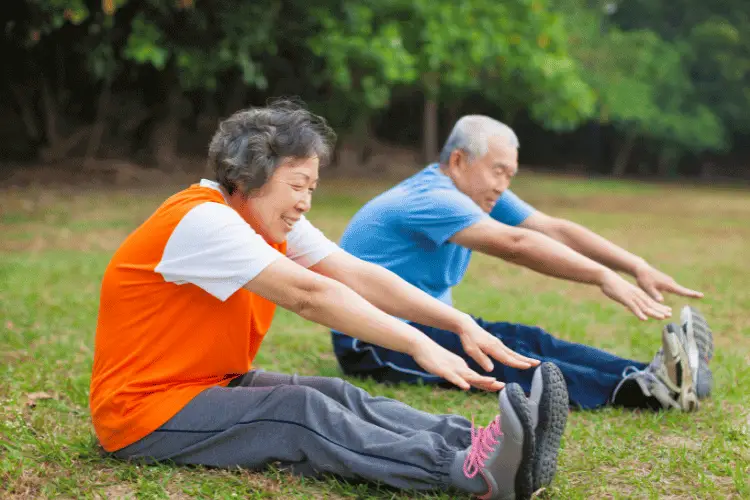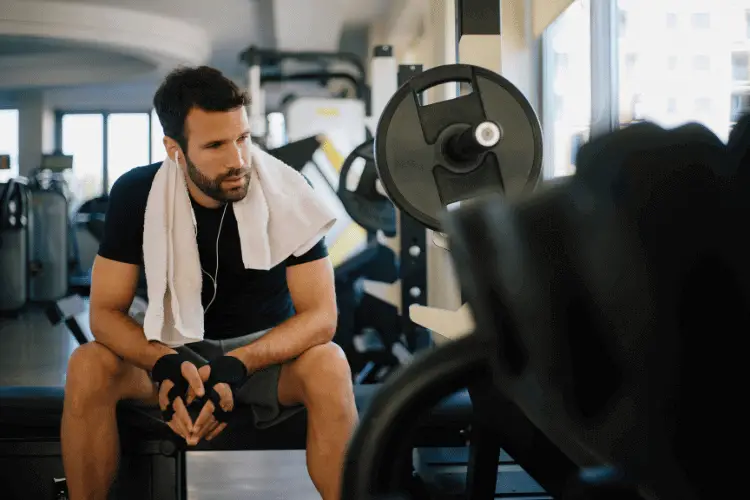From how often you should exercise to how to measure your progress, I’ve listed the most common exercise questions and answers to get you started on the right foot.
- What Are the Benefits of Exercise?
Exercise improves multiple aspects of your life. It’s the single-most effective way to manage and maintain weight, boost physical endurance, strengthen bones and muscles, reduce the risk of disease, and improve brain health. It also increases your chances of living longer.
A study published by the American Medical Association shows that an estimated 110,000 annual deaths could be prevented if adults age 40 and above exercised at least 10 minutes daily. Even something as simple as taking extra steps daily could lower the risk of premature death.
Exercise can also manage chronic health conditions and disabilities. Regular physical activity can reduce pain and improve the motor function of people with arthritis, and control blood sugar levels in people with type 2 diabetes. It likewise reduces stress and depression and enhances self-perception through successful physical activity experiences.
I could go on and on about the benefits of exercise.
- Can Exercise Extend Your Lifespan?
Without a doubt, yes! Countless studies show that exercise can significantly extend your lifespan, even when done at low intensities.
Research conducted by Harvard University shows that people who get the minimum recommended amount of physical activity—75 to 150 minutes of vigorous-intensity or 150 to 300 minutes of moderate-intensity activity per week—reduced their risk of early death by as much as 20%.
Those that exercised two to three times above the minimum amount lowered their risk even further by 30%.
Exercise isn’t only about strength and building muscle. It’s a catalyst that reduces the risk of chronic and potentially deadly disorders, like Type 2 diabetes, kidney issues, heart disease, obesity, and various types of cancer.
Studies that looked into the life expectancy of athletes revealed that retired athletes lived five to eight years longer than non-athletes. This means that going for a 30-minute walk every day can potentially increase your life expectancy by up to 10%.

- Can Exercise Shorten Your Lifespan?
Exercise doesn’t shorten your life, but exercise mistakes can.
Overexercising, for example, can increase your risk of developing overuse injuries like strained muscles, stress fractures, and tendonitis.
The human body can only take so much before it reaches its dangerous territory. Challenging yourself to do harder, tougher workouts is one thing, but pushing yourself beyond your limit is another. If the exercise leaves you feeling fatigued, exhausted, and stressed, you’re likely exercising more than your body can take.
Symptoms of overexercising include:
- Increased resting heart rate
- Muscle soreness that lasts more than a few days
- Increased number of injuries
- Lethargy and irritability after a workout
- Feelings of anxiety and depression after a workout
- Performance plateaus
But, luckily for you, if you feel these symptoms, you just need to rest for a few days to give your body a chance to recover and you’ll be fine.
Another less-talked-about exercise mistake is working out in air-polluted areas.
Breathing in polluted air is equally as dangerous and sometimes more dangerous than smoking cigarettes, reported the Energy Policy Institute.
Exercising in areas with smog increases your risk of developing coronary heart disease and lung disease. The presence of soot, dust, dirt, and other microscopic particles in smog is linked to an exhaustive list of health complications, most of which can shorten your life.
Exercising while running on a poor diet can also lead to early mortality. Exercise and nutrition go hand-in-hand; if you are malnourished, exercise could theoretically reduce muscle mass, lower bone density, and cause fatigue. It puts you at risk for injury, illness, hormonal issues, and menstrual issues for women. But you’ve got to be on a really restrictive diet for that to happen.
- How Much Exercise Do I Need to Be Physically Fit?
Adults need at least 30 minutes of moderate-intensity exercise five times a week to maintain their physical health, according to the Centers for Disease Control and Prevention (CDC).
The American Heart Association recommends more or less the same, stating that adults should exercise at least 150 minutes a week at moderate intensity or 75 minutes a week at vigorous intensity to be in peak form.
These minimum levels of exercise can be achieved by walking briskly for 30 minutes or running for 15 minutes five times a week.
If you don’t have the time to exercise every day, you can instead partake in a moderate to high-intensity sport (swimming, soccer, basketball, volleyball, etc.) for 50 minutes three days a week.
- What Does It Mean to Be Physically Fit?
People often use the terms “physically active” and “physically fit” interchangeably, but they’re two different states of being.
By definition, a physically fit person is someone who has:
- Ample strength and muscular endurance to perform an activity without feeling fatigued or expending too much force
- Healthy body composition with the right amount of muscle and fat
- Excellent aerobic endurance to perform daily tasks with power and agility
- Solid coordination
Physically fit individuals participate in regular activities that increase in length, frequency, and intensity to improve specific aspects of their bodies.
On the other hand, physically active people are those who move around or do a lot of things regularly, which doesn’t necessarily include exercise.
You need to be physically active to be physically fit, but you don’t need to be physically fit to be physically active. Both physical states are key to your health and wellness, which is why it’s so important to participate in a regular exercise regimen.
- How Often Should I Exercise to Enjoy Its Mental and Physical Advantages?
One of the best aspects of exercise is that it’s cumulative, meaning that the more you spend exercising, the more physically fit you become as you grow old.
When it comes to exercising, even a little goes a long way. You don’t need to follow a strict routine to enjoy its benefits, although exercising every day can help you build the habit.
The Department of Health and Human Services (HHS) recommends 30 minutes of exercise per day for five days, but you can adjust this to 50 minutes of exercise for three days or 15 minutes of exercise for seven days.
If you exercise most days of the week, it will do you well to switch up your exercise type and intensity to give your muscles some time to recover in between. And if you can’t find the time to exercise for extended periods, five to 10-minute bursts of activity work just as well.
As much as possible, aim for at least 150 minutes of low to moderate-intensity or 75 minutes of high-intensity exercise a week. You can break it up into small sessions or several big sessions.
- What’s the Best Time to Exercise?
The simplest answer is whenever you can. Some are better than none. It doesn’t matter when, as long as you do it.

As for the longer answer, it depends on your fitness goals.
If you’re exercising to lose weight and burn fat, morning workouts are ideal as they can boost your metabolism. The same is said for when you’re exercising to improve your sleep because morning workouts can potentially help you fix your circadian clock.
Working out in the afternoon has its merits, too. The body performs its best in the afternoon, according to studies.
By exercising between 2 pm and 6 pm, you’re using up your resources more slowly and effectively. The afternoon is also when your blood pressure and heart rate are the lowest, which decreases your chances of injury while working out.
Night-time workouts, while less popular, have proven advantages to your sleep. Low to moderate-intensity workouts before bed can help you fall asleep faster and spend more time in deep sleep.
Night-time workouts also help you mentally reset after a long, hectic day at work, allowing you to mentally disconnect from the day’s stresses through the endorphins provided by exercise.
- Can Exercise Cure Depression?
We’ve yet to find a cure for depression, but exercise is one of the few treatment options that can help keep symptoms at bay.
Exercise improves cognitive function and self-esteem, which works wonders for your mental health. It releases feel-good neurochemicals called endorphins, easing feelings of anxiety, stress, and depression. It also supports nerve cell development in the hippocampus, boosting neural growth and introducing activity patterns that promote feelings of well-being.
Exercise can act as a natural antidepressant for those who experience moderate and situational depression. People suffering from severe depression can use exercise as a form of supplement alongside therapy and medication.
- Is It Better to Exercise on an Empty Stomach?
While it’s true that exercising on an empty stomach is the fastest way to burn fat, it’s not recommended in the long run.
Your body needs fuel in the form of food to perform its best in the gym. Exercising without eating first can negatively affect your blood sugar, causing you to feel light-headed, dizzy, or nauseous during and after the exercise.
It’s therefore crucial that you eat a small snack or meal 30 minutes before and after working out. It’s also important that you drink plenty of water to keep yourself fully hydrated during your exercise.
If you typically work out during your fast, make sure you fuel up in your last meal. Have plenty of protein and carbohydrates to keep you satiated until your next meal and exercise as early in the fast as possible.
- What Foods Should I Avoid Before a Workout?
Consuming certain food items before a workout can make you feel nauseous and sick. These are the foods you should avoid:
- Spicy foods
- Snacks with refined sugar
- Dairy
- Fizzy drinks
- Fiber-filled foods (high-fiber cereals, lentils, etc.)
- Fiber supplements
- Fatty foods (fast foods, cheesy foods, fried foods, etc.)
- Complex carbs
- Nuts
- Cruciferous vegetables (broccoli, cauliflower, brussels sprouts)
- High-fat foods (avocado, bacon, fatty meats)
High-fiber foods are beneficial for your body because they regulate the digestive system and keep you full for longer. But they should be avoided before a workout because these foods take a long time to digest, leading to gastrointestinal distress like gas, cramps, reflux, diarrhea, and vomiting.
The same is said for cruciferous vegetables like cabbage, cauliflower, arugula, and broccoli. Cruciferous vegetables are high in the indigestible carbohydrate raffinose, which can trigger abdominal cramps, excessive gas, and bloating.
- What Foods Should I Eat Before a Workout?
Eating the right foods before an exercise can help you maximize the intensity, frequency, and length of your workouts. It can also boost muscle growth, speed up recovery, limit muscle protein breakdown, and restore glycogen to use in your next workout.

These are some of the best foods to eat before a workout:
- Carbohydrate-rich foods like crackers and granola bars
- Fruit smoothies
- Whole grain bread with a few slices of lean meat
- Bananas, apples, and blueberries
- Steamed vegetables
- Low-fat natural yogurt
- Low-fat or skim milk
- Low-fat cheese
- Oatmeal
- Chicken thighs
If you work out in the morning, eat 30 to 45 minutes before gym time. If you’re going for a bigger pre-workout meal, eat two to three hours prior to the exercise.
- How Much Weight Should I Use When Strength Training?
The amount of weight you should use when strength training depends on several factors, including sex, body weight, and personal goals.
For women, experts recommend starting with two sets of five to 10-pound weights and going from there. For men, start with two sets of 10 to 20-pound weights.
When strength training, your perceived exertion should fall between 7 to 9 on a scale of 1 to 10. Each rep should be significantly harder than the last.
If you can’t maintain your form before reaching 5 to 10 reps, pick a lighter set of weights. If you can easily do more than 20 reps, pick a heavier set. Increase or decrease the weight by five pounds.
But don’t take this as gospel. Some exercise programs recommend that you vary the weight and repetitions as often as possible so that your body doesn’t get used to it. So test out a few different programs and see what works for you.
- How Do I Measure My Fitness Progress?
The best way to measure your fitness progress is by setting an exercise or performance-based goal. These goals can be anything you’d like to achieve, whether it’s running a set amount of miles in a given period or lifting a specific weight.
Completing the goals you’ve set will give you an internal sense of achievement, boosting your confidence and self-esteem.
Another way to measure your fitness progress is through a fitness tracker. Fitness trackers help you measure the long-term progress of your fitness and health. These trackers let you record your heart rate, steps taken, running distance, calories burned, and sleep pattern among other things.
Other physical and mental indicators of fitness progress include:
- Better sleep
- Increased muscular strength and endurance
- Development of muscle
- Improved self-esteem and cognitive function
- Reduced feelings of stress and anxiety
Final Thoughts
I hope the exercise questions and answers above helped strengthen your knowledge of all things exercise-related.
Being physically active comes with dozens of benefits, making it one of the most important things you can do for your health. It strengthens the heart, enhances flexibility, improves blood circulation, and tones muscles.
Most importantly, exercise can reduce the risk of disease and manage chronic health conditions, leading to a longer and more fulfilling life.


